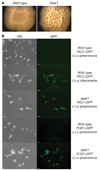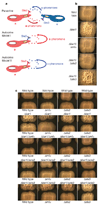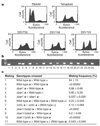Homothallic and heterothallic mating in the opportunistic pathogen Candida albicans
- PMID: 19675652
- PMCID: PMC2866515
- DOI: 10.1038/nature08252
Homothallic and heterothallic mating in the opportunistic pathogen Candida albicans
Abstract
Candida albicans is the most common fungal pathogen in humans, causing both debilitating mucosal infections and potentially life-threatening systemic infections. Until recently, C. albicans was thought to be strictly asexual, existing only as an obligate diploid. A cryptic mating cycle has since been uncovered in which diploid a and alpha cells undergo efficient cell and nuclear fusion, resulting in tetraploid a/alpha mating products. Whereas mating between a and alpha cells has been established (heterothallism), we report here two pathways for same-sex mating (homothallism) in C. albicans. First, unisexual populations of a cells were found to undergo autocrine pheromone signalling and same-sex mating in the absence of the Bar1 protease. In both C. albicans and Saccharomyces cerevisiae, Bar1 is produced by a cells and inactivates mating pheromone alpha, typically secreted by alpha cells. C. albicans Deltabar1 a cells were shown to secrete both a and alpha mating pheromones; alpha-pheromone activated self-mating in these cells in a process dependent on Ste2, the receptor for alpha-pheromone. In addition, pheromone production by alpha cells was found to promote same-sex mating between wild-type a cells. These results establish that homothallic mating can occur in C. albicans, revealing the potential for genetic exchange even within unisexual populations of the organism. Furthermore, Bar1 protease has an unexpected but pivotal role in determining whether sexual reproduction can potentially be homothallic or is exclusively heterothallic. These findings also have implications for the mode of sexual reproduction in related species that propagate unisexually, and indicate a role for specialized sexual cycles in the survival and adaptation of pathogenic fungi.
Figures




Comment in
-
Microbial genetics: Love the one you're with.Nature. 2009 Aug 13;460(7257):807-8. doi: 10.1038/460807a. Nature. 2009. PMID: 19675638 Free PMC article. No abstract available.
References
-
- Samaranayake LP, et al. Fungal infections associated with HIV infection. Oral Dis. 2002;8 Suppl. 2:151–160. - PubMed
-
- Wisplinghoff H, et al. Nosocomial bloodstream infections in US hospitals: analysis of 24,179 cases from a prospective nationwide surveillance study. Clin. Infect. Dis. 2004;39:309–317. - PubMed
-
- Hull CM, Johnson AD. Identification of a mating type-like locus in the asexual pathogenic yeast Candida albicans. Science. 1999;285:1271–1275. - PubMed
-
- Hull CM, Raisner RM, Johnson AD. Evidence for mating of the “asexual” yeast Candida albicans in a mammalian host. Science. 2000;289:307–310. - PubMed
-
- Magee BB, Magee PT. Induction of mating in Candida albicans by construction of MTLa and MTLα strains. Science. 2000;289:310–313. - PubMed
Publication types
MeSH terms
Substances
Grants and funding
LinkOut - more resources
Full Text Sources
Other Literature Sources
Molecular Biology Databases

